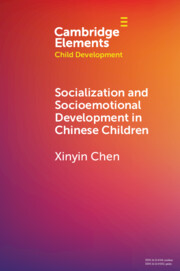Element contents
Socialization and Socioemotional Development in Chinese Children
Published online by Cambridge University Press: 24 February 2023
Summary
- Type
- Element
- Information
- Series: Elements in Child DevelopmentOnline ISBN: 9781009072380Publisher: Cambridge University PressPrint publication: 09 March 2023
References
- 11
- Cited by



